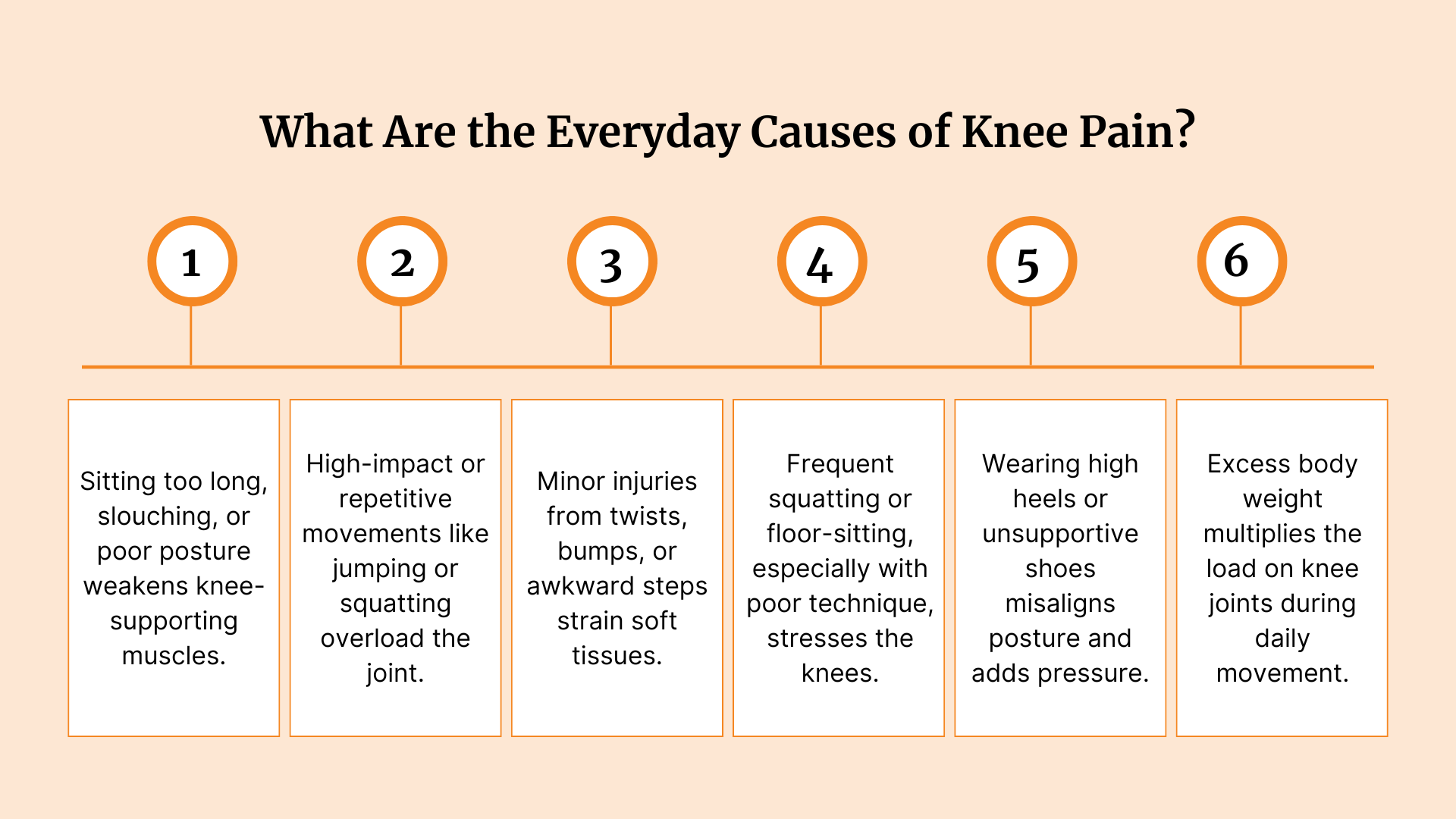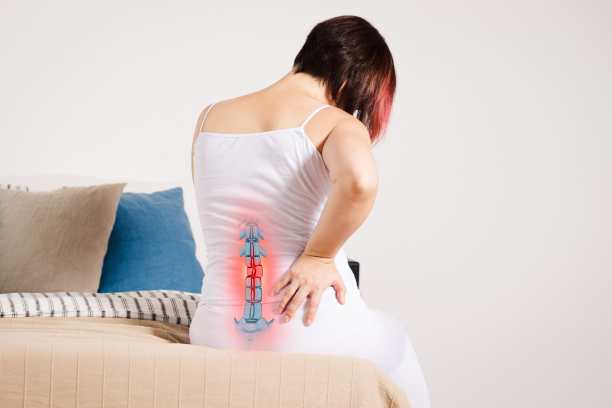Knee pain is a common complaint that affects numerous people regardless of their age. It usually ranges between mild pain after a long day and a disabling ache that makes even walking difficult. It is crucial that you understand why your knee hurts, as it is the first step towards relief.
Often, knee pain is connected with everyday habits or minor injuries that you may overlook easily. However, in some cases, it may also indicate a medical condition, such as ligament damage or arthritis. In this blog, we will explore the most common causes of knee pain, ranging from lifestyle-related factors to prevalent medical issues in India, and discuss practical solutions for each.
From easy-to-implement home remedies to consulting a doctor, we will cover everything that helps you keep your knees healthy, allowing you to stay active and pain-free.
What are the Everyday Causes of Knee Pain?
One of the major contributors to knee discomfort is lifestyle factors, as well as everyday activities. Several knee-related issues develop over time due to the way we sit, move, and choose our footwear. The following are some day-to-day causes of knee pain:
1. Sedentary lifestyle and poor posture
Sitting for long hours, especially in a desk job, or slouching can weaken and stiffen the muscles around the knee. Lack of movement restricts blood flow to the joint, causing it to ache when you finally stand up or move. Poor posture, such as sitting cross-legged or hunching, can misalign the knee joint and increase strain. To prevent this kind of pain, keep your feet flat on the ground and take regular breaks to stretch and relax.
2. Overuse and repetitive strain
On the other hand, physical activity in excess or repetitive strain can irritate knee structures. Activities such as jumping, heavy manual labour, or running long distances put repeated stress on your knees. Orthopaedic experts in India suggest that deep squatting movements, such as lifting something heavy from the ground, can result in a momentary load on the knees that is up to seven times your body weight. Overuse can result in tendinitis or patellofemoral pain syndrome, characterised by irritation under the kneecap due to repetitive use.
3. Minor injuries and sprains
Knee pain may also arise simply due to an injury that you may not even recall. An awkward step off the curb, bumping your knee, or a sudden twist of the leg can sprain or stretch the soft tissues around the joint. This leads to micro tears in the ligament or an irritated joint lining. This causes pain and swelling in the joint. Usually, rest and basic first aid are sufficient to heal such minor injuries.
4. Frequent squatting and floor-sitting
In India, people often squat or sit on the floor for meals, prayers, or while using Indian-style toilets. These habits involve knee bending. While these habits are part of our daily lives, engaging in them excessively or with poor technique can severely impact your knees. Several orthopaedic surgeons note that repeatedly rising from a full squat position places immense stress on the knees. Over the years, it can lead to wear-and-tear arthritis.
5. Improper footwear
Footwear, surprisingly, has a significant impact on your knees. Shoes such as high heels or ones with poor support affect your gait and posture. This puts extra pressure on the knee joint. For example, high heels force your body weight onto the balls of your feet. This results in misalignment in the knee and added stress on your kneecaps. Over time, wearing high heels often may lead to joint degeneration. An AIIMS Specialist has warned that wearing high heels might become a leading cause of osteoarthritis in women. On the other hand, walking barefoot or wearing flat shoes on hard surfaces may also stress the knees.
6. Excess body weight
Being overweight or obese is an everyday strain on the knee joints. Each time you walk or climb the stairs, your knees are forced to support your body weight. Every extra kilogram adds four times the strain on your knee joints when you move. This excessive load accelerates the wear and tear of the cartilage and can further lead to chronic knee pain or, in some cases, an early onset of osteoarthritis. Several studies in India have linked the increased risk of knee joint pain and damage to excessive weight. Losing even a small amount of weight can bring great relief to your knees.

Remedies and Prevention Tips for Knee Pain
Many common causes of knee pain, such as strain, mild injury, or early wear and tear, can be prevented by implementing simple practices and habits at home. These measures and lifestyle upgrades can significantly reduce pain and help you improve your knee function. Some home remedies and self-care tips to help your aching knees are below:
1. Rest and activity modification
Allowing your knee to rest is crucial, especially during the initial few days of an injury or flare-up. Avoid activities that may worsen the pain. For example, stop heavy lifting and high-impact exercises for a while. However, do not completely immobilise your knees. It is advisable to rest intermittently and gently move your knee to a comfortable range to prevent stiffness. Most importantly, listen to your body. If an activity is causing pain, ease up and let yourself recover.
2. Cold and warm therapy
Within the first 48 hours of a knee injury, ice packs can play a crucial role. Applying ice wrapped in a cloth for 15 to 20 minutes can help numb the pain and limit potential swelling. Do not ice your skin directly. Once the initial acute phase has passed, heat therapy can benefit your aching and stiff knees. Using a heat pack, warm towel, or warm compress on your knee can improve blood circulation and relax your muscles, thereby easing discomfort.
3. Compression and elevation
Compression involves applying gentle pressure to the knee to help reduce swelling. You can wrap your knee with an elastic bandage or wear a neoprene knee sleeve, something that is snug but not so tight that your leg feels numb or tingly. Proper compression can control swelling and provide support to the joint. Elevating the leg is another effective method to combat swelling. Prop your leg up on a pillow while you are resting, such that it’s above your heart level.
4. Strengthening exercises
While initially it is critical to get an ample amount of rest, long-term relief requires movement. You must focus on strengthening the muscles around your knees — specifically the quadriceps (front of the thigh), hamstrings (back of the thigh), and calf muscles — as this is one of the most effective ways to prevent future pain and stabilise the knee. Start with gentle exercises only after your acute pain has subsided. Simple activities, such as straight-leg raises, stretching exercises, and mild knee bends, can be done at home.
5. Weight management
As stated earlier, having excess weight forces more pressure and strain on your knees. Losing even a few kilograms can make a significant difference if you are overweight. It reduces the pressure your knees have to bear with each step and often leads to a noticeable improvement in mobility and comfort. Combining exercises with changes in your diet can help you achieve weight loss. Weight control is an effective preventive strategy in a country like India, where osteoarthritis is on the rise, mainly due to lifestyle changes.
6. Proper footwear and supports
A good pair of shoes can provide immense support to your feet and knees. Supportive footwear helps correct your posture and gait by reducing abnormal stress on your knees. Choose shoes that have good arch support, a stable base, and sufficient cushioning. Avoid walking long distances in worn-out shoes or sandals that offer no support. If you have high arches or flat feet, custom insoles, such as arch supports, will help your legs align properly.
.png)
Conclusion
Knee pain can be frustrating, but with the right approach, you can usually find relief and get back to your normal activities. The causes of knee pain range from everyday habits, like how you sit or what shoes you wear, to medical issues like arthritis or injuries. By paying attention to these factors, you can often prevent or minimise knee problems. Simple steps such as staying active, maintaining a healthy weight, using proper posture, and strengthening your leg muscles will go a long way in keeping your knees healthy.
With a combination of good habits and proper care, you can overcome knee pain and continue to lead an active, pain-free life.
References
- Ensure Long Term Knee Health With These Tips, https://www.ndtv.com/health/ensure-long-term-knee-health-with-these-tips-8747996
- Stop squatting, avoid knee problems: Surgeons | Nagpur News - Times of India, https://timesofindia.indiatimes.com/city/nagpur/stop-squatting-avoid-knee-problems-surgeons/articleshow/54384930.cms
- Knee pain | Causes, treatments and self-management, https://versusarthritis.org/about-arthritis/conditions/knee-pain/
- Joint pains, arthritis going up in India, says WHO study: Know what’s causing them | Health and Wellness News - The Indian Express, https://indianexpress.com/article/health-wellness/joint-pains-arthritis-cases-causes-who-study-9892838/
- Knee pain: Symptom When to see a doctor - Mayo Clinic, https://www.mayoclinic.org/symptoms/knee-pain/basics/when-to-see-doctor/sym-20050688
- Knee Injury Information and Advice — Chelsea and Westminster Hospital NHS Foundation Trust, https://www.chelwest.nhs.uk/your-visit/patient-leaflets/medicine-services/knee-injury-information-and-advice
- Curcumin for arthritis: Does it really work? - Harvard Health, https://www.health.harvard.edu/blog/curcumin-for-arthritis-does-it-really-work-2019111218290










